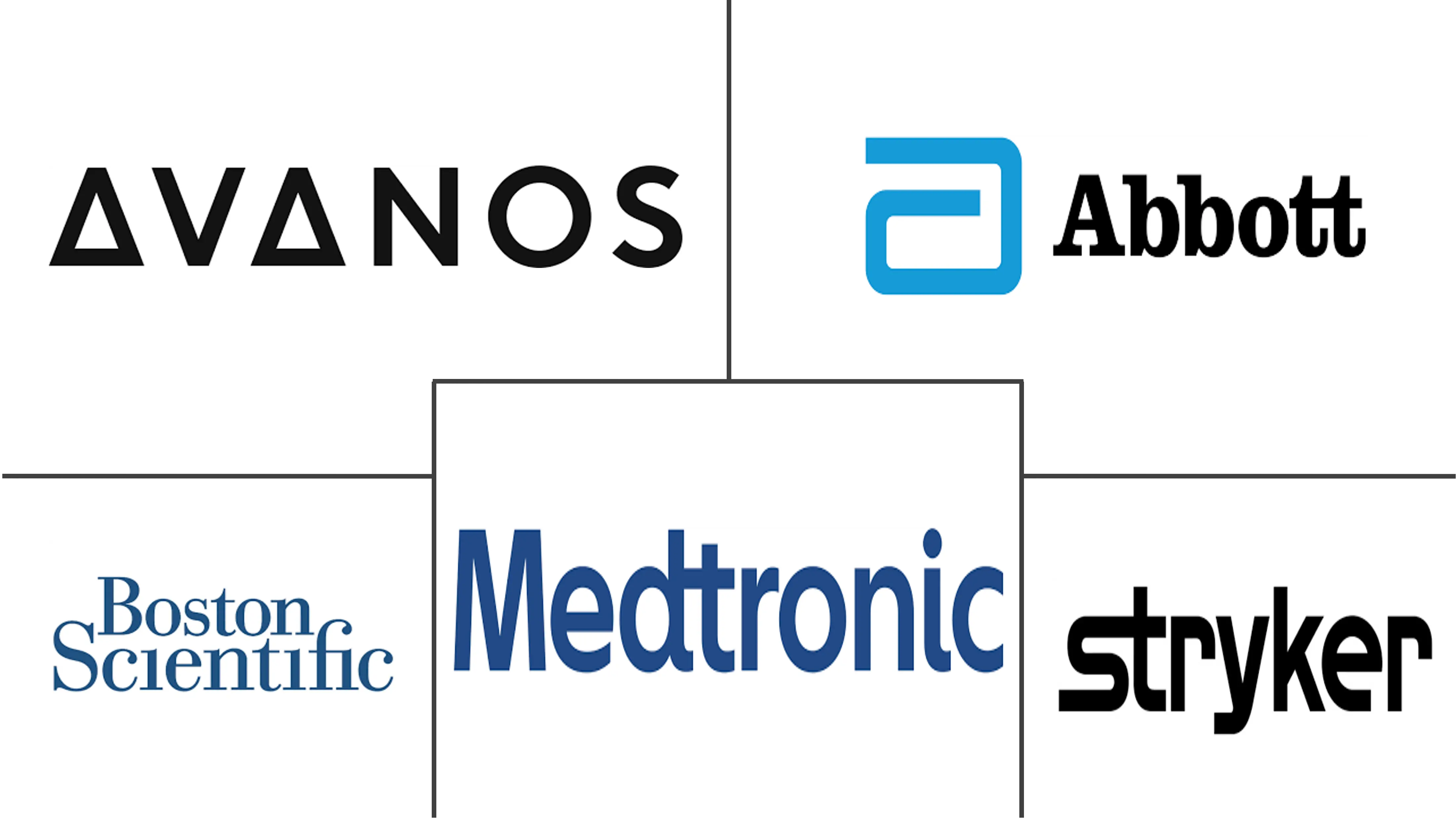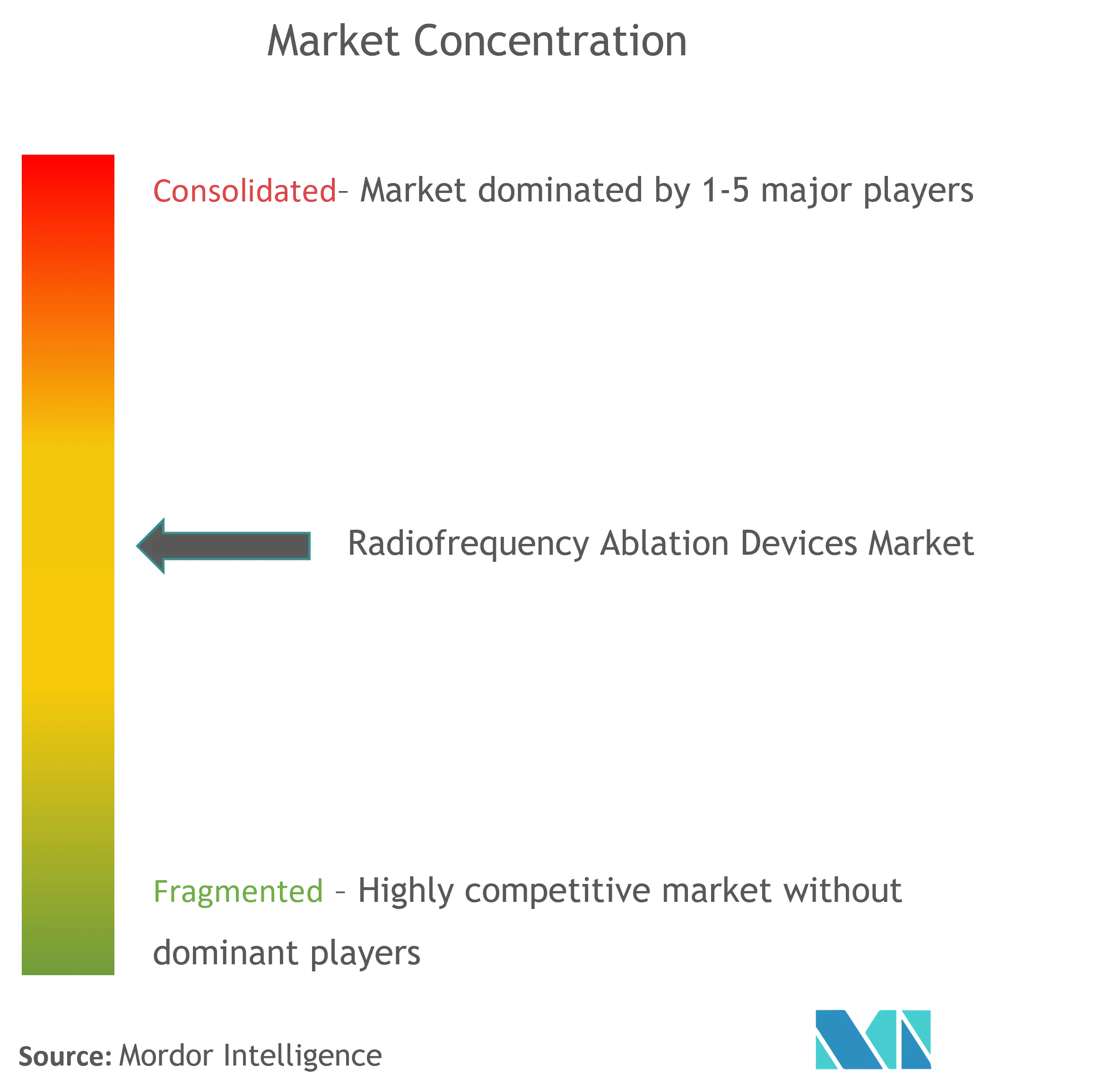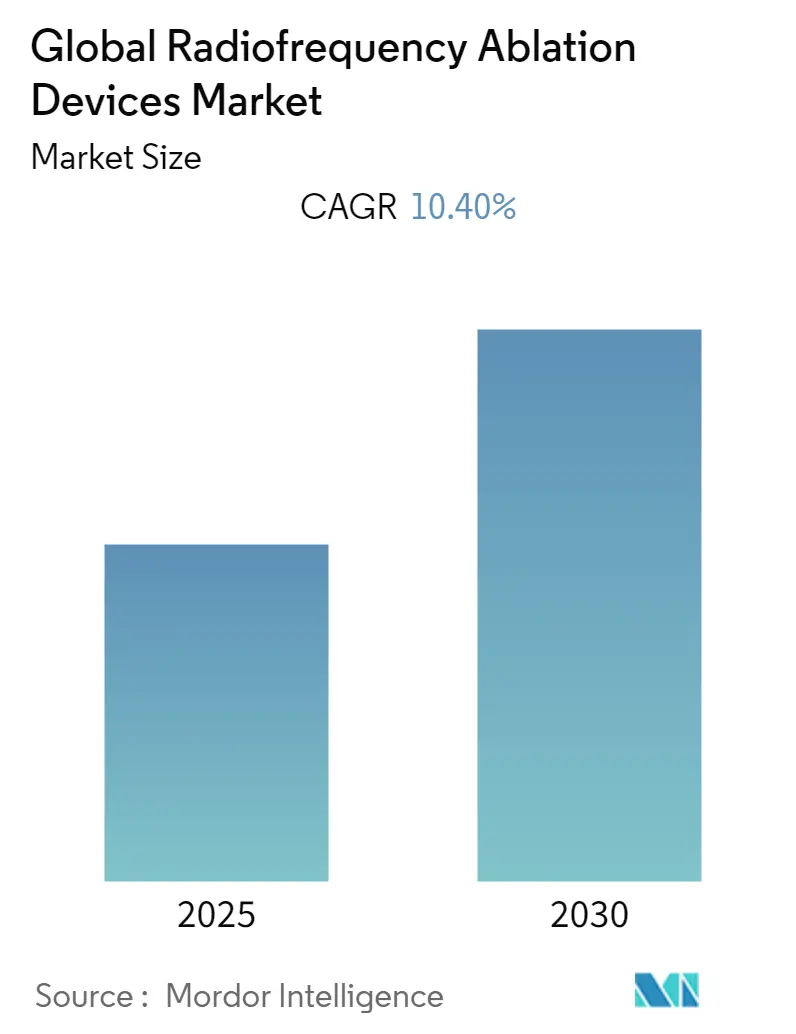
Radiofrequency Ablation Devices Market Analysis
The Global Radiofrequency Ablation Devices Market is expected to register a CAGR of 10.4% during the forecast period.
The COVID-19 pandemic affected healthcare systems globally and resulted in the interruption of usual care in many healthcare facilities, exposing vulnerable patients with cancer to significant risks. For instance, a study titled "Impact of the COVID-19 Pandemic on Cancer Care: A Global Collaborative Study" published in 2020 reported that there were several challenges in delivering cancer care based on a survey of a total of 356 centers from 54 countries across six continents that participated between April 21 and May 8, 2020. These centers serve 716,979 new patients with cancer every year. Most of them (88.2%) reported facing challenges in delivering care during the pandemic. Although 55.34% of the centers reduced their services as part of a preemptive strategy, other common reasons included an overwhelmed system (19.94%), lack of personal protective equipment (19.10%), staff shortage (17.98%), and restricted access to medications (9.83%). Moreover, catheter ablation procedures for atrial fibrillation (AF) were significantly curtailed during the peak of the COVID-19 pandemic to conserve healthcare resources and limit exposure. According to the study "Rebooting atrial fibrillation ablation in the COVID-19 pandemic," published in February 2021, there were no cases of ablation-related COVID-19 transmission in the study population. However, there were a smaller number of transesophageal echocardiography procedures performed in 2020 as compared to 2019 despite a greater prevalence of persistent arrhythmia in 2020, indicating that healthcare resources were reutilized for COVID-19 care. As a result, fewer ablation procedures were performed, thereby negatively impacting the market. Thus, such circumstances greatly affected the market's growth rate throughout the initial pandemic phase. However, the market is anticipated to gain traction as several elective and cancer care procedures have resumed to pre-pandemic levels across the globe.
The factors propelling the studied market growth are the increasing prevalence of minimally invasive procedures, the growing burden of chronic diseases, and the senior population. For instance, as per the 2020 statistics by GLOBOCAN 2020, 19,292,789 people were diagnosed with cancer in 2020. According to the same source, the number of people with cancer is estimated to reach 30.2 million by 2040. Thus, increasing cancer prevalence indicates a rising need for effective minimally invasive surgical procedures for cancer, thereby driving the demand for radiofrequency ablation devices.
Additionally, strategic initiatives such as product launches, mergers, acquisitions, partnerships, and others will lead to lucrative market growth. For instance, in March 2022, Shijiazhuang Suin Instruments Co., Ltd. launched an RF signal generator, an instrument that's especially used to produce RF signals for carrier tests.
Furthermore, the rising research and development studies proving the efficacies of existing products in the market are expected to further contribute to the market's growth. For instance, the article "Next-generation catheter cuts AF ablation time," published in January 2022, evaluated the Biosense Webster's Qdot Micro catheter and demonstrated that it is a contact force-sensing radiofrequency ablation catheter with temperature-controlled ablation and 3D electroanatomical mapping integration. It incorporated advanced, high-energy ablation, improved temperature monitoring, optimized irrigation, and higher signal resolution, providing physicians with a simplified workflow that helps shorten procedure time. These advantages of radiofrequency ablation devices are expected to increase their adaptability, thereby driving the market growth. Moreover, in February 2022, Ramesh hospitals launched a modernized cardiac electrophysiology lab in Vijayawada, India, which will incorporate new therapies such as radio frequency ablation, pacemakers, automatic implantable cardiac defibrillators, and others. Thus, such initiatives will increase the demand for radio frequency devices, thereby driving the market growth.
Therefore, owing to the factors above, the studied market is expected to grow significantly during the study period. However, low awareness and availability of alternative treatment methods and high treatment costs are expected to hinder the market's growth during the forecast period.
Radiofrequency Ablation Devices Market Trends
Oncology Segment is Expected to Account for the Largest Market Share During the Forecast Period
The oncology segment holds a major share of the radiofrequency ablation devices market. The rising number of cancer cases around the world is adding to segmental growth. For example, a September 2021 World Health Organization (WHO) update stated that cancer resulted in approximately 10 million deaths worldwide. The most common cancers in 2020 (according to new cancer cases) were: breast cancer (2.26 million cases); lungs (2.21 million cases); colon and rectum (1.93 million cases); prostate (1.41 million patients); skin (non-melanoma) (1.20 million cases); and stomach (1.09 million cases). This increase in the number of cases over the years is majorly contributing to the increase in surgical therapies for efficient treatments, which in turn will propel the demand for ablation devices.
Furthermore, according to an article published by RadiologyInfo.org updated in February 2021, radiofrequency ablation (RFA), a minimally invasive treatment for cancer, employs an image-guided technique to apply heat to destroy cancer cells. RFA uses ultrasound, computed tomography (CT), or magnetic resonance imaging (MRI) to guide a needle electrode into a cancerous tumor and passes high-frequency electrical currents through the electrode to ground pads placed on the body, thereby creating focused heat that destroys the cancer cells surrounding the electrode. The article also suggested that radio frequency and microwave ablations are the most commonly used ablation treatment methods for cancer therapy.
In addition, the growing investment in research and development will also increase the availability of radiofrequency ablation devices in the treatment of various types of cancer, thereby accelerating the segment's growth. For example, the study titled "Endoscopic Radiofrequency Ablation (RAF) Combined With Gemcitabine and S-1 in Patients for Unresectable Cholangiocarcinoma: A Randomized Open-Labeled Clinical Trial" was initiated in January 2020 by the First People's Hospital of Hangzhou to compare the efficacy and safety of RAF combined with Gemcitabine and S-1 in patients with unresectable cholangiocarcinoma. This study is expected to be completed by June 2022. Therefore, the positive results from such practices will spur the segment's growth.
Therefore, the studied segment is expected to project lucrative growth over the analysis period.
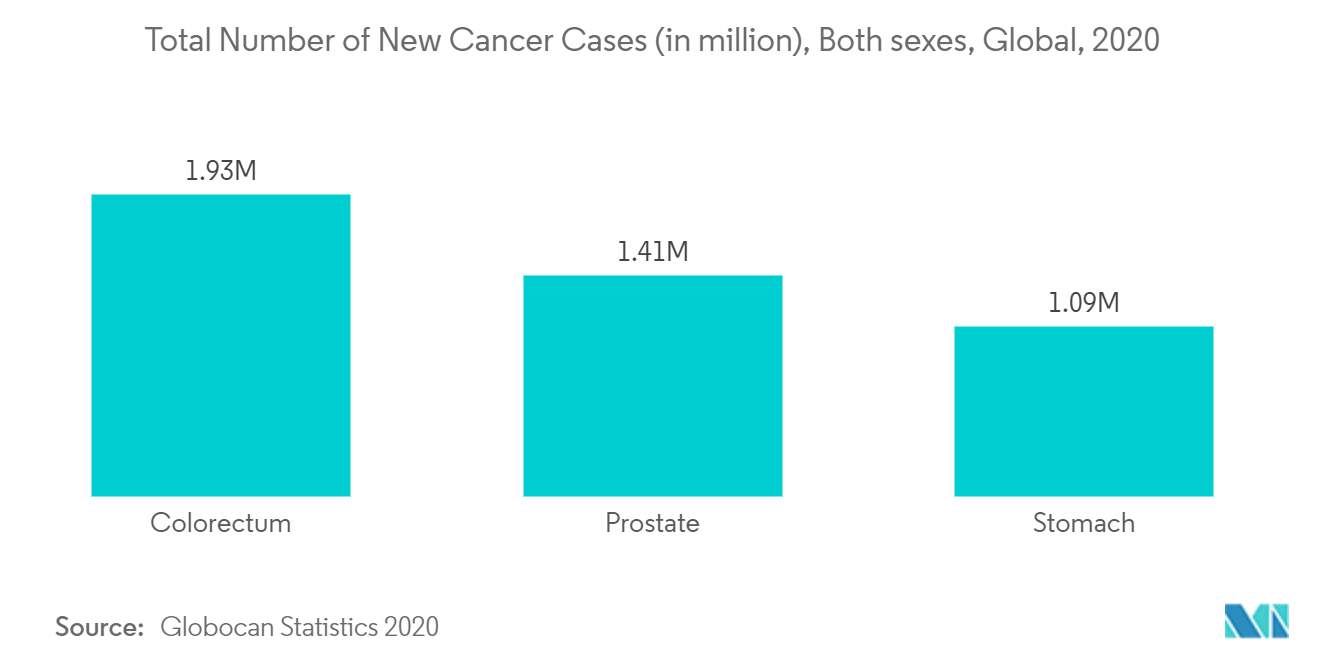
North America is Expected to Hold a Significant Share in the Market and Expected to do Same over the Forecast Period
The primary driving factors for the growth of the North American radiofrequency (RF) ablation devices market are the increasing prevalence of chronic diseases; increasing demand for minimally invasive surgeries; increasing product launches; and rising strategic initiatives by key market players. The United States is expected to hold a significant share in the studied market in the North American region during the forecast period. For instance, according to the estimates of the 2022 American Cancer Society, Inc., about 236,740 new cases of lung cancer will be diagnosed in the country in 2022. The same source also stated that 79,000 new cases and 13,920 deaths will be reported in 2022 from kidney cancer. Thus, the high burden of cancer is expected to boost the demand for ablation devices, thereby driving the market growth.
Moreover, strategic initiatives undertaken by the key market players, such as product launches, partnerships, new programs, mergers, and acquisitions, are likely to drive market growth. For instance, in February 2021, the Food and Drug Administration approved Medtronic's DiamondTemp irrigated ablation catheter in the RF cardiac ablation space, designed to treat patients with recurrent atrial fibrillation that has not responded to drug therapies.
Furthermore, in November 2020, Abbott launched the IonicRF Generator, which is expected to deliver a non-surgical, minimally invasive treatment for managing pain in the nervous system. The IonicRF Generator is a radiofrequency ablation device that uses heat to target specific nerves and block pain signals from reaching the brain. Thus, launching such products will expand the company's offerings and geographical footprint, driving market growth over the forecast period.
Thus, these aforementioned factors are anticipated to boost the growth of the market in the region over the coming years.
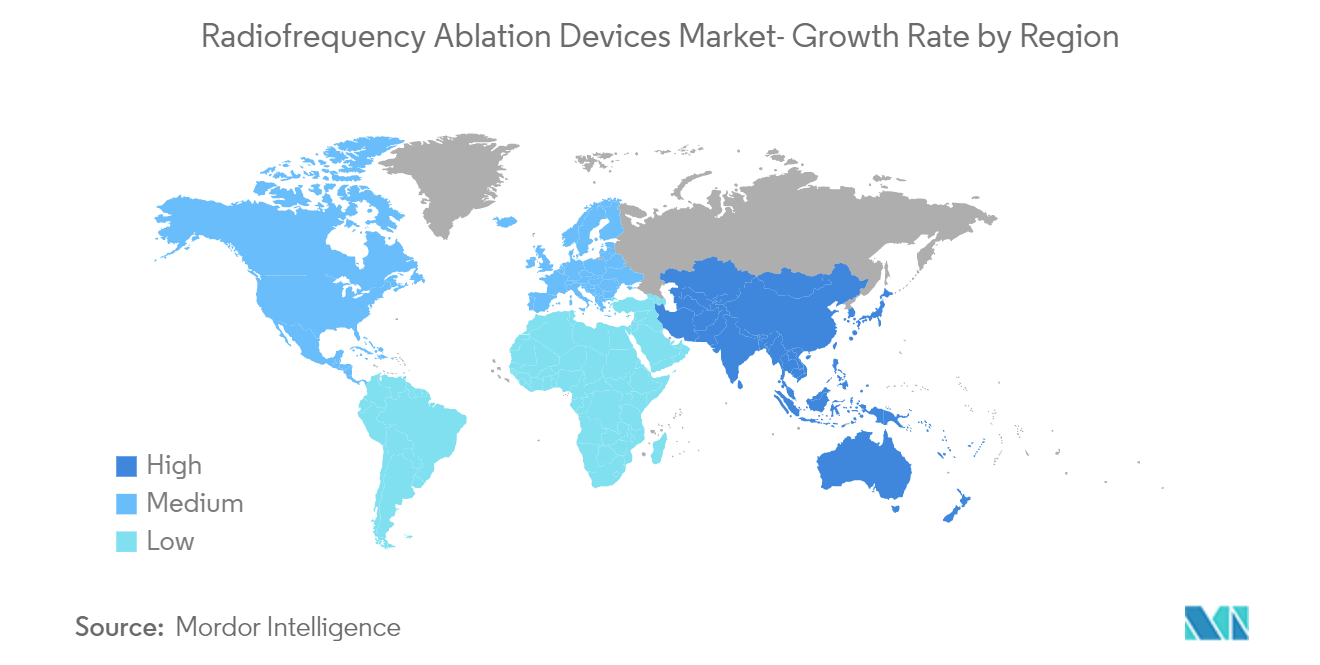
Radiofrequency Ablation Devices Industry Overview
The market is moderately competitive with major players dominating the market. The major players in the market are Avanos Medical Inc., Stryker, Abbott, Medtronic, Boston Scientific Corporation, and Others.
Radiofrequency Ablation Devices Market Leaders
-
Avanos Medical, Inc.
-
Stryker
-
Abbott
-
Medtronic
-
Boston Scientific Corporation
- *Disclaimer: Major Players sorted in no particular order
Radiofrequency Ablation Devices Market News
- In April 2022, AtriCure launched the EnCompass Clamp as part of its Isolator Synergy ablation system. The platform includes parallel closure, uniform pressure, and custom power using synergy radiofrequency, which will be used for the ablation of cardiac tissue during cardiac surgery to make concomitant surgical ablations more efficient.
- In April 2022, Royal Philips launched the latest release of its KODEX-EPD system, which offers enhanced imaging and mapping capabilities for RF ablation, including the new Tissue Engagement Viewer and support for Medtronic DiamondTemp ablation system.
Radiofrequency Ablation Devices Industry Segmentation
As per the scope of the report, radiofrequency ablation is a medical procedure in which part of the electrical conduction system of the heart, tumor, or other dysfunctional tissue is ablated using the heat generated from medium-frequency alternating current. The devices used for these procedures are known as radiofrequency ablation devices. The Radiofrequency Ablation Devices Market is Segmented by Product Type (Radiofrequency Generators and Consumables), Application (Oncology, Cardiology and Cardiac Rhythm Management, Gynecology, Pain Management, and Other Applications), and Geography (North America, Europe, Asia Pacific, Middle East and Africa, and South America). The market report also covers the estimated market sizes and trends for 17 countries across major global regions. The report offers the value (in USD million) for the above segments.
| By Product Type | Radiofrequency Generators | ||
| Consumables | |||
| By Application | Oncology | ||
| Cardiology and Cardiac Rhythm Management | |||
| Gynecology | |||
| Pain Management | |||
| Other Applications | |||
| Geography | North America | United States | |
| Canada | |||
| Mexico | |||
| Europe | Germany | ||
| United Kingdom | |||
| France | |||
| Italy | |||
| Spain | |||
| Rest of Europe | |||
| Asia-Pacific | China | ||
| Japan | |||
| India | |||
| Australia | |||
| South Korea | |||
| Rest of Asia-Pacific | |||
| Middle-East and Africa | GCC | ||
| South Africa | |||
| Rest of Middle-East and Africa | |||
| South America | Brazil | ||
| Argentina | |||
| Rest of South America | |||
Radiofrequency Ablation Devices Market Research FAQs
What is the current Global Radiofrequency Ablation Devices Market size?
The Global Radiofrequency Ablation Devices Market is projected to register a CAGR of 10.4% during the forecast period (2025-2030)
Who are the key players in Global Radiofrequency Ablation Devices Market?
Avanos Medical, Inc., Stryker, Abbott, Medtronic and Boston Scientific Corporation are the major companies operating in the Global Radiofrequency Ablation Devices Market.
Which is the fastest growing region in Global Radiofrequency Ablation Devices Market?
Asia-Pacific is estimated to grow at the highest CAGR over the forecast period (2025-2030).
Which region has the biggest share in Global Radiofrequency Ablation Devices Market?
In 2025, the North America accounts for the largest market share in Global Radiofrequency Ablation Devices Market.
What years does this Global Radiofrequency Ablation Devices Market cover?
The report covers the Global Radiofrequency Ablation Devices Market historical market size for years: 2019, 2020, 2021, 2022, 2023 and 2024. The report also forecasts the Global Radiofrequency Ablation Devices Market size for years: 2025, 2026, 2027, 2028, 2029 and 2030.
Our Best Selling Reports
Radiofrequency Ablation Devices Industry Report
Statistics for the 2025 Global Radiofrequency Ablation Devices market share, size and revenue growth rate, created by Mordor Intelligence™ Industry Reports. Global Radiofrequency Ablation Devices analysis includes a market forecast outlook for 2025 to 2030 and historical overview. Get a sample of this industry analysis as a free report PDF download.

